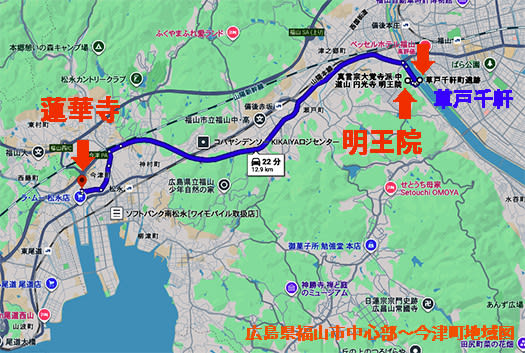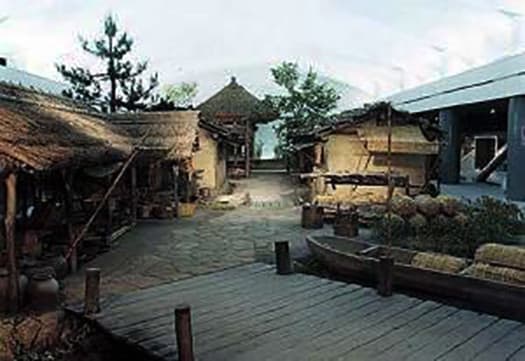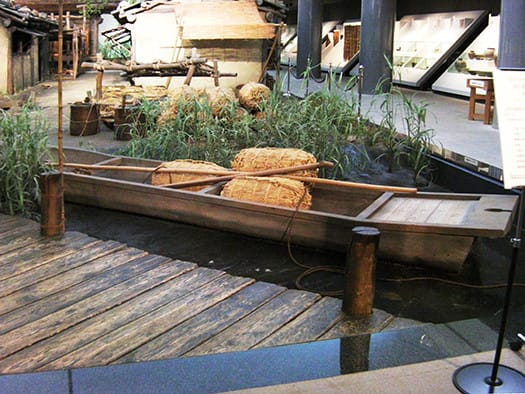


先日まで安藤忠雄建築の姫路文学館関連の探訪記を記していましたが、加齢とともにだんだんいろいろ探訪行脚の領域・地域が広がっていく趨勢。きのうお知らせしたようなノンフィクション作品の取材対象に興味が広がってきたことから、建築と人間、その暮らしようというフィールドに大きく展開してきているのですね。
そういうことで、家系に縁のある福山市今津の寺院「蓮華寺」を探訪の途次に訪問していたのですが、その住職様から貴重な資料類をちょうどご恵送いただいたところなのです。こちらの寺院とは先代住職のときからなにくれと縁が繋がっているのですが、いまはその娘さんが住職を引き継がれていて、非常に活発に宗教文化の発掘に余念がない。はるかな縁者として非常にうれしく、その動向を注視させていただいています。地元の福山市の「ふくやま美術館」で〜ふくやまの仏さま〜国宝明王院本堂本尊三十三年ぶり特別公開・特別展開催とのこと(昨年12月15日まで)。こちらの様子を伝える展示会図録・資料類を送付いただき、その様子を知ることができました。
おお、であります。もう13年前になるけれど草戸千軒遺跡(写真の下2枚)について深く感銘を受けていた記憶がわたしの中に甦り、同時に遺跡と深く関わる「明王院」についても回想されてきていたのです。当時の探訪ではたまたま今津の蓮華寺も距離的には近くにあるのだなぁ程度に漠然と感じていたのですが、仏教文化面としてはそれらの地域的な関連性が強く浮き彫りにされていて、一気に中世以来の草戸千軒遺跡・民の生き様とわが家家系の人びとの事跡の残影がくっきりと明示的になってきたのです。「そうか、こうした時代の空気の中でご先祖様たちは、あのように行動したのか」と。
これまで感覚のレベルまでは感受することが出来なかった、歴史事象とわが家の家系伝承とがクロスし始めてきて、ひとびとのいとなみの実像が沸き立つように迫ってくる感じがしております。仏像や仏画の作者や、その作られようから当時の時代の空気、人間のこころのさざ波のようなものがリアリティを持って伝わってきた。宗教というものに人びとがどのような「祈り」を捧げたのか、そういう心象がみえてきた思いなのですね。
仏画の説明文の中にも、これも先日触れた現代量子科学的な解析「死は存在しない」の文中での宗教と科学の出会いのような臨場感、現場感覚と似た、共通する部分があると感じられてならない。
どうもいろいろな「出会い」が重なってきているように思われます。宗教的に言えば「機縁」ということなのでしょうが、淡々とその領域を深掘りしてみたい。
English version⬇
Kusado-Senken to Imazu: The history and culture of the Fukuyama area, Hiroshima Prefecture.
A sense of a dramatic ‘door being opened’ when the results of my own explorations and various analyses meet. I would like to explore this opportunity in depth in a straightforward manner. ...
Until the other day, I had been writing about my explorations of the Tadao Ando Himeji Museum of Literature, but as I get older, the areas and regions I visit are gradually expanding. As my interest in the subjects of non-fiction works, such as the one I wrote about yesterday, has expanded to include architecture, people and the way they live.
I was visiting Renge-ji Temple in Imazu, Fukuyama City, which is related to my family history, and the abbot of the temple has just sent me some valuable materials. I have been connected with this temple since the time of the previous abbot, whose daughter has now taken over as abbot, and she has been very active in discovering religious culture. As a distant relative, I am very happy to be able to keep a close eye on her movements. The Fukuyama Museum of Art in Fukuyama City, my hometown, is holding a special exhibition of the main temple of the national treasure Meio-in temple, the Buddha of Fukuyama, for the first time in 33 years (until 15 December last year). We were sent the exhibition catalogue and materials to learn more about the exhibition.
Oh, yes. It was 13 years ago, but the memory of being deeply impressed by the Kusado-Senken site (bottom two photos) came back to my mind, and at the same time I was reminded of the Meio-in Temple, which was deeply connected to the site. At the time of the visit, I had only a vague impression that Renge-ji Temple in Imazu was also nearby by chance in terms of distance, but the regional relationship between them in terms of Buddhist culture was strongly highlighted, and the traces of the life of the Kusado-Senken site and its people since the Middle Ages and the people of my family lineage became clear and evident at once. The traces of the life of the Kusado-Senken site and its people since the Middle Ages, as well as the traces of the people of my family, became clear. I was able to see the traces of the life of the Kusado-Senken site and its people since the Middle Ages, and the traces of the people of my family.
Historical events and our family traditions, which until now we have not been able to perceive at the level of the senses, are beginning to cross over, and I feel that the real image of people's lives is coming to the surface in an exciting way. The creators of Buddhist statues and paintings, and the way they were made, conveyed the reality of the atmosphere of the times and the ripples of the human spirit. I felt that I could see the mental images of how people prayed for religion.
In the explanatory text of the Buddhist paintings, I cannot help but feel a sense of reality and a sense of the scene, like the encounter between religion and science in the text of the modern quantum scientific analysis ‘Death does not exist’, which I mentioned the other day.
Apparently, various ‘encounters’ seem to be coming together. In religious terms, this may be called ‘kiki-en’, but I would like to delve deeper into this area in a nonchalant manner.




























※コメント投稿者のブログIDはブログ作成者のみに通知されます